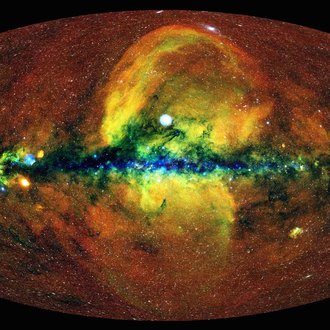eROSITA


eROSITA stands for extended ROentgen Survey with an Imaging Telescope Array and is the main instrument on the Russian spacecraft Spektrum-Roentgen-Gamma (SRG). eROSITA consists of an array of 7 identical X-ray telescope modules, each of those of 54 individual mirrors that have a common focus. Each module is equipped with a frame-store CCD for the detection of X-rays in the energy range between 0.2 and 10 keV. The main goal of the eROSITA project is the completion of 8 independent all-sky surveys at X-ray energies between 0.2 and 10 keV within the first 4 years of the mission. The SRG satellite was launched into a Sun-Earth L2 halo orbit at a distance of 1.5 million km from Earth in July 2019. The X-ray all-sky surveys began in December 2019. eROSITA was built under the leadership of the Deutsches Zentrum für Luft- und Raumfahrt (DLR) and the Max-Planck-Institute for Extraterrestial Physics (MPE, Garching) with contributions from several German institutes in Tübingen, Hamburg, Bamberg, and the AIP. The AIP built the MGSE (mechanical ground support equipment) and provides comprehensive data analysis software for the reduction and analysis of the original satellite data.
A detailed description of the eROSITA science case can be found in the eROSITA Science Book (PDF 19 Mb), a description of the finally integrated instrument and its properties in space in Predehl et al. (2020) and an animation of the mission scenario on youtube.
Funding: DLR, 50QR0802, 50QR1604, 50QR2104
Partners:
Core institutes: Max-Planck-Institut für Extraterrestrische Physik; Universität Hamburg; Universität Tübingen; Dr. Karl Remeis-Sternwarte, Universität Erlangen
Associated institutes: Universität Bonn; LMU München
Overall lead, coordination and funding: Deutsches Zentrum für Luft- und Raumfahrt
